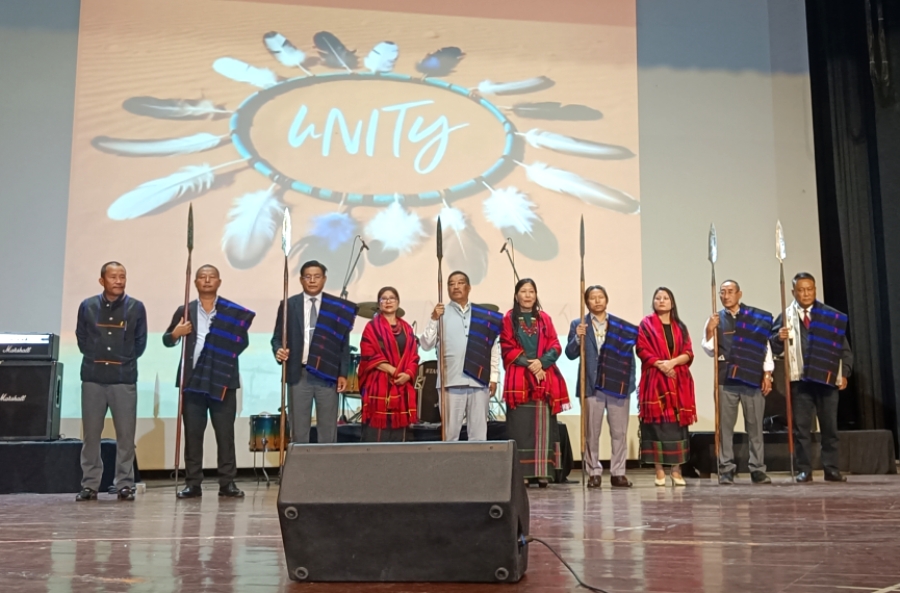WEDNESDAY, OCTOBER 08, 2025
- Home
- Cultural exchange marks prelude to Kohima Lotha Hoho golden jubilee
Cultural exchange marks prelude to Kohima Lotha Hoho golden jubilee
Cultural exchange at RCEMPA Jotsoma marks prelude to Kohima Lotha Hoho golden jubilee, promoting unity and Naga cultural harmony.
Share

KOHIMA — A cultural exchange programme as a prelude to the 50 years of Kohima Lotha Hoho was organised at RCEMPA, Jotsoma, on Wednesday, with participation from all the Naga tribes, including the Poumai, Mao, Tangkhul, Garo, Kuki, and Nepal communities.
The event, held on the theme “Integrating cultures for common good”, aimed to recreate the mosaic dynamism of ancestral traditional cultural heritage.
The programme was organised by Kohima Lotha Hoho with participants from Kohima-based tribal bodies. It was announced that the golden jubilee will be celebrated on November 7.
Kekhrielhoulie Yhome, advisor for school education and SCERT, Nagaland, who was the special guest, said that due to the political situation of the Nagas, people perhaps have failed to understand each other’s distinctive characteristics and to recognise their different identities.
“We should recognise each other’s differences and not suppress differences in identities. We have to rethink about how to go ahead,” he said.
Also read: Tir Yimyim celebrates 22nd anniversary with launch of Ao-English translation site
He further mentioned that urbanisation brings a lot of stress but emphasised that love must spread among colonies and neighbourhoods to build the city of Kohima. “As we become more and more cosmopolitan, we have to reinvent our identities, cultures and ways of communication,” he added.
Mhathung Yanthan, advisor for Agriculture, stated that Kohima Lotha Hoho has stood as a guardian of cultural identity, a voice of the people, and a partner in the journey of community building.
He extended gratitude to Kohima Lotha Hoho for conceiving the idea of the cultural exchange programme and for organising it by inviting all the Naga tribes of Kohima, noting that the initiative is not only about bringing the tribes together but also fostering stronger relationships and deepening the bonds of unity among the citizens of Kohima.
WATCH MORE:
He added that the programme was a conscious step to celebrate the richness of cultures and to remind everyone that the strength of Nagaland lies in the diversity of its people.
Y Mhonbemo Humtsoe, MLA, shared that the Kohima Lotha Hoho has played a vital role over the decades in upholding the traditional identity of the Lotha community in the state capital. It has been a unifying platform promoting understanding, fostering brotherhood, and preserving cultural identities, he said.
He maintained that the programme reminds everyone that culture is not merely about custom and region but about values. “As we stand at the threshold of the celebration, let us renew our commitment to work together for unity, transcending differences and striving for peace, progress and development not only within our community but among all other tribes,” he shared.
Tradition and culture binds Nagas together
Achumbemo Kikon, MLA, reminded that looking at the actual map of the Naga ancestral area, only one-fourth of the Nagas live in the state of Nagaland. He reiterated that a major chunk of the Naga people live in Burma (present-day Myanmar) and that in India, Nagas are found in Assam, Arunachal Pradesh, Manipur and Nagaland.
He observed that without delving into political issues, such a gathering of Nagas is not common because “actually what binds us is the political issue”. Despite the geographical differences, he stated that what binds Nagas together is tradition and culture.
Read more: Nagaland signs MoU with Capacity Building Commission for Mission Karmayogi
He recalled how the Nagas have come a long way from headhunting, narrating stories from the elders that headhunting was not a war between tribes but between villages, and therefore, there is no enmity between tribes as far as Nagas are concerned.
He stated that he does not agree with the theory of one tribe against another, saying, “If you hear or read such a thing, it is only a fiction of imagination and some people with ulterior motives to create one tribe against another.”
He also mentioned that the Lothas are one community that always leads with the idea and vision that Nagas must come together and form a united platform.
Mhondamo Ovung, chairman of Lotha Hoho, in his speech expressed that the programme is a step towards Naga unity. He urged everyone to move beyond narrow, emotional philosophies like tribalism. He further urged and advised everyone to move towards Naga unity.
He appealed to everyone to participate wholeheartedly in the future programmes of the Kohima Lotha Hoho golden jubilee and build a paradigm shift towards Naga unity.
Thejao Vihienuo, president of the Angami Public Organisation, also spoke about the early Lotha settlers in Kohima and expressed gratitude for their contribution in building Kohima town.
He urged the Lotha community in Kohima to carry forward the legacy of the early settlers and to further strengthen the bond between the Angamis and the Lothas, requesting that the Lothas organise another friendship programme with the Angamis.
Dr. Thanghoi Lam, president of Khiamniungan Union Kohima, speaking on behalf of the Kohima-based tribal bodies, shared words of appreciation for the tribes of Nagaland for their immense contribution to the development of the Nagas.
He also spoke about the growing factions and divisions among the Nagas, lamenting that ordinary people bear the brunt of these issues. He appealed for unity among the Nagas, questioning whether the Naga people can achieve their vision amid so many divisions.
He pointed out that many Nagas are praying day and night, working hard, and some even sacrificing their lives to change the lives of the Nagas. He urged the Nagas to realise what they need to do for the betterment of their people.

